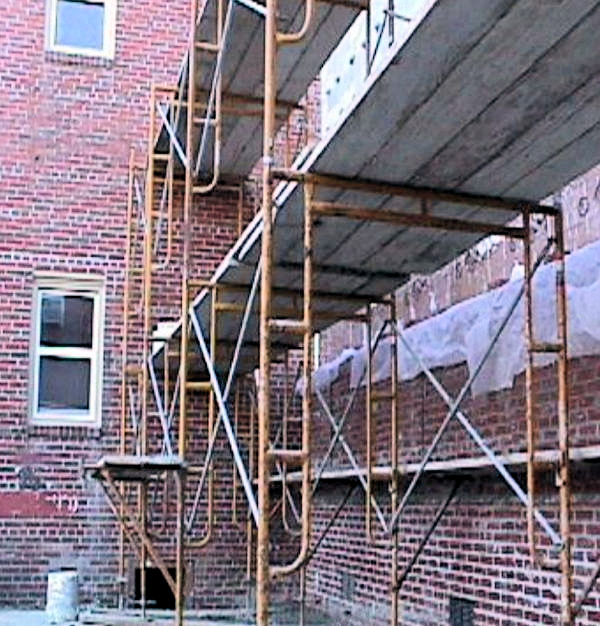22.B.15 Planking.
- All wood planking must be selected for scaffold plank use as recognized by grading rules established by a recognized independent inspection agency for the species of wood used.
- The maximum permissible spans for 2-in x 10-in (5-cm x 25.4-cm) (nominal), must be 8 ft (2.4 m) or 2-in x 9-in (5-cm x 22.8-cm) (rough) solid sawn wood planks must be 10 ft (3 m).
- Fabricated planks and platforms may be used in lieu of solid sawn wood planks. Maximum spans for such units must be as recommended by the manufacturer.
- Planking must be secured to prevent loosening, tipping, or displacement and supported or braced to prevent excessive spring or deflection. Intermediate beams must be provided to prevent dislodgement of planks due to deflection. > See Section 24.A.04.
- Each platform on all working levels of scaffolds must be fully planked or decked between the front uprights and the guardrail supports as follows:
- (1) Each platform unit (e.g. scaffold plank, fabricated plank, fabricated deck, or fabricated platform) must be installed so that the space between adjacent units and the space between the platform and the uprights is no more than 1 in (2.5 cm) wide, except where the employer can demonstrate that a wider space is necessary (e.g., to fit around uprights when side brackets are used to extend the width of the platform).
- (2) Where the employer makes the demonstration as described in 22.B.15.e.(1), the platform must be planked or decked as fully as possible and the remaining open space between the platform and the uprights must not exceed 9 1/2 in (24.1 cm).
- When planking is lapped in a long run, each plank must lap its supports at least 12 in (30.4 cm). Scaffold planks must extend over their end supports not less than 6 in (15.2 cm) (unless the planking is manufactured with restraining hooks or equivalent means of preventing movement) or more than 12 in (30.4 cm). Work surfaces must be properly lapped or securely fastened to the scaffold.
- Where the ends of planks abut each other to form a flush floor, the butt joint must be at the centerline of a pole and abutted ends must rest on separate bearers.
- The front edge of all platforms must not be more than 14 in (36 cm) from the face of the work, unless guardrail systems are erected along the front edge and/or personal fall arrest systems are used; the maximum distance from the face for plastering and lathing operations is 18 in (46 cm).
- Planking must be supported or braced to prevent excessive spring or deflection and secured and supported to prevent loosening, tipping, or displacement.
- When a scaffold materially changes its direction, the platform planks must be laid to prevent tipping.
- (1) The planks that meet the corner bearer at an angle must be laid first (unless hook- on fabricated planks are used), and extend over the diagonally placed bearer far enough to have a good safe bearing, but not far enough to involve any danger from tipping, and;
- (2) The planking running in the opposite direction at an angle must be laid so as to extend over and rest on the first layer of planking.
- Planks must be maintained in good condition. When cracks exceed 1.5 times the width of the board, the plank will not be used. Planks with notches deeper than 1/3 the width of the plank will not be used. Planks with saw kerfs (a groove or notch) must not be used.
22.B.16 When moving platforms to the next level, the existing platform must be left undisturbed until the new bearers have been set to receive the platform planks.
22.B.17 Materials must not be stored on scaffolds or runways in excess of supplies needed for that shift.
Knowledge Check Choose the best answer for the question.
22-4. How far may scaffold planks, made without means of preventing movement, extend over their end supports?
You forgot to answer the question!

